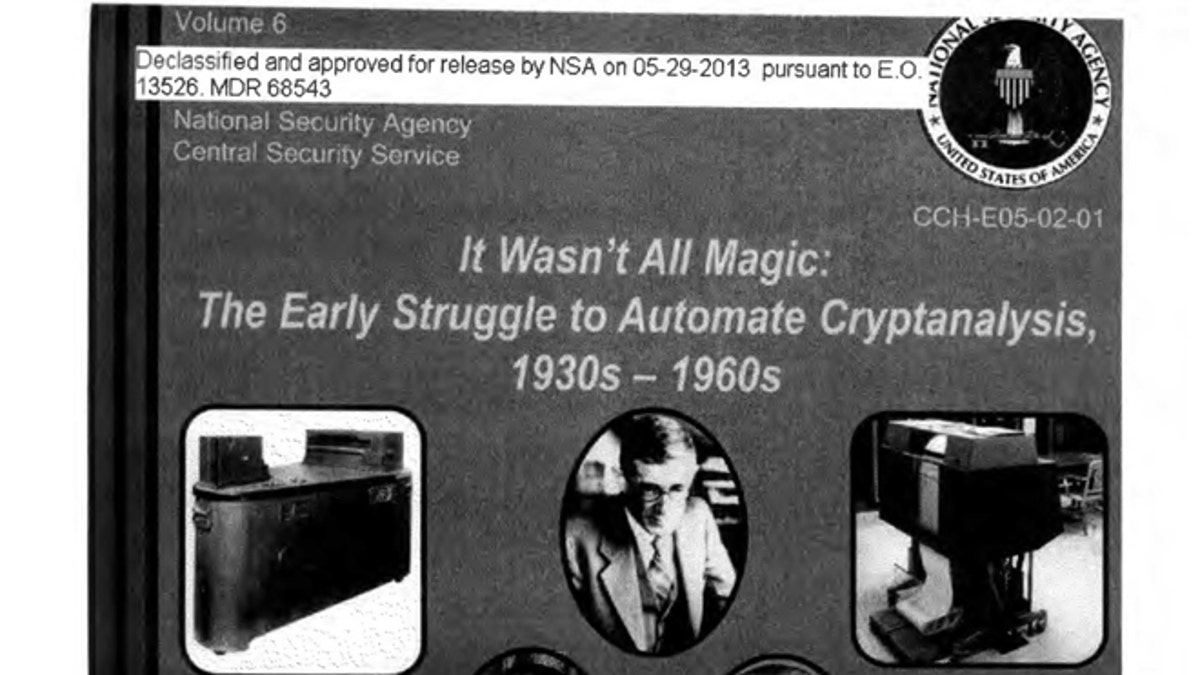
The cover for a recently declassified NSA report detailing the spy agency's pioneering work in the early computer industry.
The clandestine National Security Agency is partly responsible for the modern PC era, a newly declassified document reveals, thanks to decades of custom computers built for one thing: espionage.
Declassified by the NSA on May 29 and posted online on Monday, the 344-page report “It Wasn’t All Magic: The Early Struggle to Automate Cryptanalysis, 1930s – 1960s,” details the unknown high-tech history of computers so secretive even their code names were kept confidential.
Until now.
It’s a never-before seen history of code-breaking, spying and its role in the birth of the computer.
'This is a story that has been little told until now due to the secrecy of these programs.'
“NSA has arguably been the largest single user of advanced computing machines in the world,” reads the introduction to the report, written by Colin Burke, former scholar-in-residence at the NSA and recently retired professor of history at the University of Maryland, Baltimore County. “[The NSA’s] computer purchases and its research and development contracts helped establish America as the world's leading computer manufacturer.”
They have names like Mercury, Rattler, Madame X, MAGIC Atlas and Abner, and some of the early machines have never been mentioned before.
This side to the spy agency is an intriguing one, explained one of the editors behind the independent clearinghouse Government Attic website that obtained the documents, who asked that his name not be used.
“Most computer histories discuss these early machines being used to calculate naval gun ballistic tables, but the truth is that most of them were developed specifically for code-breaking purposes,” he told FoxNews.com.
Government Attic placed a Freedom of Information Act (FOIA) request for the document on Aug. 4, 2012; when it was posted on Monday, the surge of intrigued visitors was so great that it overwhelmed the site’s servers, knocking the site offline.
“This document … reveals the breadth and also the intensity and urgency of early computer development for code-breaking purposes in World War II and afterward by the U.S. Government and its private partners,” he told FoxNews.com.
“This is a story that has been little told until now due to the secrecy of these programs,” he said.
The document walks through pioneering work by MIT scientist Vannevar Bush to automate cryptanalysis as early as 1936, thanks to “optical scanning, high-speed data tapes, electronic computing, and microfilm in a series of increasingly complex cryptanalytic machines.”
His colleagues thought his recommendations were speculative and "liable to be very costly failures,” the document notes. Besides, a commercial company was already hard at work in the field: IBM. But after a decade of work, Bush developed a system called N/A that sounds remarkably like one of today’s spying system.
When it was first revealed that the NSA was obtaining phone data from Verizon, the agency was said to be reading metadata: not the contents of phone calls but transactional information, such as duration of calls, originating number, routing information, and so on.
A similar system was created by Naval Research Lab engineers in an effort to listen in on enemy communications during World War II.
"By 1940, [Navy cryptanalysis branch] OP-20-G's intercept crews were logging thousands of messages a month from the Pacific and the Atlantic, and the method was considered essential,” the report reads. The 70-year-old spy technique relied on metadata in which “the concern was not with the content of messages but with the easily identified callsigns of senders and receivers, the timing and numbers of messages in a network, and the shifts in patterns of transmissions.”
As the country fought the Cold War during the 50s, the demands of intelligence gathering again led the agency to push forward computer design, not always successfully. At least one project, called NOMAD, was an embarrassing failure, the report notes.
But there were successes as well, such as Pluto, a $333,000 electronic machine built by Sylvania. “Pluto used 26-foot by 20-foot frames crammed with vacuum tubes … Pluto ran through 1,000,000 settings a minute and was so precious that only a handful of the most trusted codebreakers were informed of its existence.”
And at one point, Rapid Arithmetic Machine (RAMs, or special purpose computers) built by the NSA were arguably the most powerful computers in the world.
“By the early 1960s, NSA's ‘basement’ became one of the world's great computer data processing centers,” the report says.




















